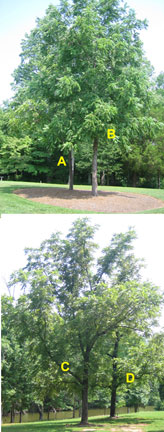Question:
 I have four large walnut trees in my yard in South Carolina that need to be cut down.
I'd like to find someone who will buy the logs. How can I find a buyer and someone to cut them down, and how much would the logs be worth?
I have four large walnut trees in my yard in South Carolina that need to be cut down.
I'd like to find someone who will buy the logs. How can I find a buyer and someone to cut them down, and how much would the logs be worth?
Answer:
We get this question from time to time and it's not an
easy one to answer. If you desire to "sell" the trees in partial or
full exchange for the job of cutting them down, it's helpful to know the ins and outs of
turning a tree into lumber (and hopefully, money). Understand that
this might not be as simple as described here depending on where you live.
Begin by searching the Internet for
information regarding the process of turning a standing tree into
usable lumber. There is a brief but good overview entitled "Selling
Trees for Lumber" at
ehow.com
.
It can be a
tricky task for the first-time seller as issues of valuation,
insurance, equipment, and transport all come into play. However the Internet
is a wonderful place to start and offers tons of information and
possibilities. Be sure to consider all the issues very carefully however as
they are all very important for the success of the project.
To find someone or some company to do the job, there are many
resources to explore. Try the local or regional woodworkers or
woodturners association. They may have members capable of doing the
job, and as a bonus, will turn the harvested wood into objects of beauty, a win-win situation. These associations are located in every state
and can be found through an Internet search.
Another great resource
is your state forestry department. For example, the state of South
Carolina has an extensive list of sawmills operating throughout the state, complete with contact
information. Other states may offer this as well. A sawmill may be able to guide you through the process
by specifying the steps needed to get your tree to their mill (whether that mill is portable or in a fixed location).
A warning in advance. Some sawmills will not want to risk damage to their sawblade that might be caused by striking nails and other metal objects
that are more likely to be found in logs from trees growing near people's homes as opposed to trees that grew in the wild.
On the surface, the idea of selling trees for the value of their lumber may seem easy, but you do need to be realistic.
Find out if your
project is economically viable. Examine the numbers closely and if
possible, get bids on the job.
Remember that having insurance to cover liability and potential property damage when trees are being cut down is critical.
If you really want to follow through, you'll need to
keep a positive attitude as you explore the options available to you. Altogether this may turn out to be a big job. Good
luck with it and happy sawing.
Return to
Wood News
front page
